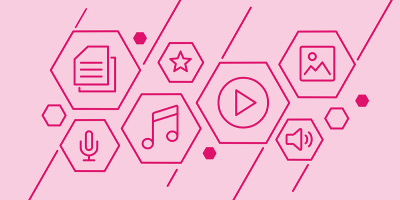
Six Not-So-Complicated Ways to Get to Know Your Audience

As a marketer, it’s your job to get to know the people you’re trying to reach. You likely know a lot about them already, and that’s valuable. But audiences are complex. Over time, they grow and evolve. Their wants, needs, goals, and pain points change right along with the environment around them. And, while it’s tempting to rely on audience assumptions that have taken hold over the years, you need to know what content and information they need from you today.
So let’s learn more about what your customers want from you now. Here are six not-so-complicated ways to get to know them.
1. Have a good old-fashioned conversation
It’s amazing what you can learn from a conversation. Talk with your existing or prospective customers, as well as coworkers who regularly engage with them. Whether you spend five extra minutes at the end of a client meeting or talk with your sales and customer service representatives, make time for honest and straightforward conversations.
Often, product teams will have a “won-lost” session after the sales process is complete. During this time, they ask questions about why your product was or wasn’t selected. These conversations can provide valuable insights to you and your fellow marketers, helping you zero in on what’s resonating with customers.
User experience, or UX, teams also talk to a lot of users. Tap into these conversations to get feedback on everything from the user interface (UI) to customer support. Remember, it doesn’t have to be the marketing team talking directly with customers because a lot of these conversations are already happening — you just have to find out who’s having them.
Seek out a variety of people to better understand what your audience needs at different stages in their buyer journey. We also recommend recording direct quotes and questions from your discussions to inform your content strategy and keep creative efforts on track.
2. Dig up data
Google Analytics, search engine optimization (SEO) tools, and a host of software options means you likely have a wealth of audience data at your fingertips. But before you dive into that sea of information, hone your efforts. What do you want to learn about your audience?
Focusing your research on a specific goal can make analysis easier. Perhaps you want to know if your audience cares about the how-to videos your sales team distributes every Friday. Kick off a hyper-focused content audit by pulling stats on the content your audience consumes.
But, in some cases, audience insights are best generated by technology like machine learning, which can study massive volumes of data to identify patterns that teams wouldn’t notice without devoting several hours, if not days or months, to sifting through information like transaction histories or social media engagement. For instance, it might take a customer data platform (CDP) to tell you that your biggest online sales day is Tuesday, not the weekend, so maybe you should schedule your email marketing to send discount codes on Mondays. Or a digital asset management (DAM) system may be needed to tell you which brand assets your teams are overusing. Don’t overlook the support that technology can offer!
3. Survey them
Recruit a group of people representative of your target audience and survey them. But remember: All survey methods are not created equal. Figure out which ones will get you the info you need without annoying your audience.
For some, including a survey as part of a marketing-automation strategy works. For others, one-on-one conversations or hiring a research firm is the ticket. But, above all, make sure you talk to the right people. Establishing qualifiers in advance, such as demographic targets, helps shield against sample-group missteps.
4. Be the party starter
Summon your inner cruise-ship coordinator and get people in your target market talking and socializing. And then, kick back and listen. By bringing like-minded people together, you stimulate authentic and natural peer-to-peer conversations. Organize a Meetup in your local community, start a LinkedIn group, or host an industry event. You can guide and ignite conversations but let your guests vent, swap stories, and swap knowledge while you take it all in.
At Acquia, we have regular user group sessions to bring customers together. This is not only helpful for our system admins but our marketing and product teams also get to learn more about what’s on our customers’ minds.
5. A/B test
Test assumptions you have about your audience with a split test. Also known as an A/B test, it’s a systematic way of comparing two variants to determine which version performs best.
Let's say you want to understand if your audience responds better to an image of your product or a lifestyle shot that captures how your product makes someone feel. Run a Facebook ad with two different images or even serve two versions of your website to visitors and track the results. Be sure to manipulate just one variable at a time. If you change the image, plus another variable like the copy, you won't know which factor drove the response to the ad.
6. Seize the opportunity
Learning about your audience not only helps you market better, but it also shows you care. These are actual people you’re talking to, so of course you want to find courteous, thoughtful ways to approach them.
Asking questions, listening, and having authentic conversations is a good thing by most standards. Entertaining a client? Get their take on your latest product release. Speaking at an event? Get your audience involved with call-and-response techniques. Always, always, always take the opportunity to learn.
The end (or is it?)
There are endless ways to get to know your audience. Whether you talk with them, analyze engagement data, conduct surveys and tests, or simply embrace curiosity, you must be in constant pursuit of audience truths and challenge your assumptions so you can give your audience the relevant, helpful, and memorable content they need.
At Acquia, we’re always looking to learn more from our customers. In fact, customer feedback informs much of our new and updated product functionality. We also provide our customers with visibility into our product roadmap so they can see what we’re working on and let us know their thoughts. After all, if it’s not helpful for our customers, then why do it?
So, if you want to boost your efforts with technology like a DAM platform or CDP and are curious how we do things at Acquia, request, watch, or click through a demo to learn more.



